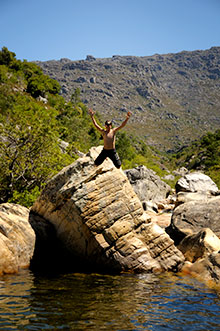Discover the secret of the Winelands
Begin your journey of exploring Bainskloof here.

Bainskloof is named after Andrew Geddes Bain who in 1849, with the help of several hundred convict laborers built an 18 kilometer pass through the Limietberg mountains of Wellington. The project were completed in September 1853. Bain, a Scotsman and self-taught engineer, held the position of Road Inspector for the Cape colony which were granted to him by the Central Road Council in 1845. Although the pass was originally a dirt road built essentially for horse drawn traffic, it received a tar coating in 1934.
The Bainskloof Pass is situated on the provincial road R303 which originates in Wellington and forks into the R43 (towards Wolseley & Ceres) and R46 (towards Worcester) respectively. It's easy to navigate your way to the pass. When in Wellington, position yourself at the Andrew Murray Dutch Reformed Church and drive down Church Street. This will take you on an eastward trip out of town. After about 2.6km you'll pass Bovlei Winery on your right and with another 400 meters worth of drive you will pass the Redemption leather factory on your left. Continue on this road and you will soon (1.4km later) drive past Kleinevalleij on your left and another 900 meters will bring you to Bakkies B&B on your right. By now the slope will gradually get steeper and another 10km uphill drive will take you to the heart of the Bainskloof Pass. On a clear day you you can be the owner of a breathtaking view. Wellington, Paarl, Stellenbosch and even Table Mountain are now within visual reach as the Cape Winelands unfolds below you.
Some quick Bainskloof facts:
- Bainskloof, situated in the Cape's floral kingdom, is unique in that it contains the highest ratio of plant species per land area in the world - a total of 8600 species of which 5800 is endemic
- The flora of Bainskloof encompasses an astounding 277 varieties of flowering plants. These include 24 types of Erica, 10 types of Gladioli and 13 types of Protea
- Bainskloof's fauna includes a selection of a 182 bird species in addition to otters, jackals, leopards, honey badgers, klipspringers, grysbok, steenbok, endangered frogs and some unique fish swimming in the streams
- Scotsman Andrew Geddes Bain built Bainskloof Pass. It was the first inland passage to the north and South Africa's interior
- Completed in 1853, the pass became one of the most scenic routes in the Cape
- The pass traverses the Limietberg mountains, establishing a route between the town of Wellington and the interior
- The pass were completed in 4 years (1608 working days)
- An average of 53 days were devoted to a kilometer of construction
- Bainskloof is part of the Limietberg Nature Reserve and was declared a National Monument in 1980
- The pass lies within a natural heritage area that forms part of the Cape Floral Region, one of 8 world heritage sites in South Africa as established by Unesco's World Heritage Committee at the 29th session in Suzhou, China in July 2004
- The pass gradient from Wellington rises from 300m to 595m above sea level
- A dry-masonry method of construction was used to build the pass
- The pass lies within an area that is rich in fynbos with multiple Protea species
- Bainskloof attracts many ecotourists, particularly in the spring and summer months
- Adventurers flock to Bainskloof to participate in mountain biking, hiking and swimming in the fresh water pools
- The unspoilt nature of Bainskloof makes it an ideal area for environmental field workshops from universities or exploration by researchers
- Bain's Cape Mountain Whisky, a single grain whisky distilled at The James Sedgwick Distillery in Wellington was named after Andrew Geddes Bain
- The Bainskloof Ultra Marathon is an annual event which entails running the Pass as part of the route
Notes
Much of the historical literature on this site was originally researched and written in Afrikaans by various litterateurs and historians.
We'd love to hear from you if you happen to come across any historical or grammatical inaccuracies, or if you have additional information about Bainskloof that you wish to contribute - just use the contact form.
Bibliography: A.P. van Zyl: Bainskloof, Departement Afrikaanse Kultuurgeskiedenis, Universiteit van Stellenbosch, 1995; Keith MacKenzie: The Story of Bain’s Kloof Pass, December 1993; N.S. Serfontein: Bain, Buskruit en Bandiete, Universiteit van Stellenbosch, 1992.